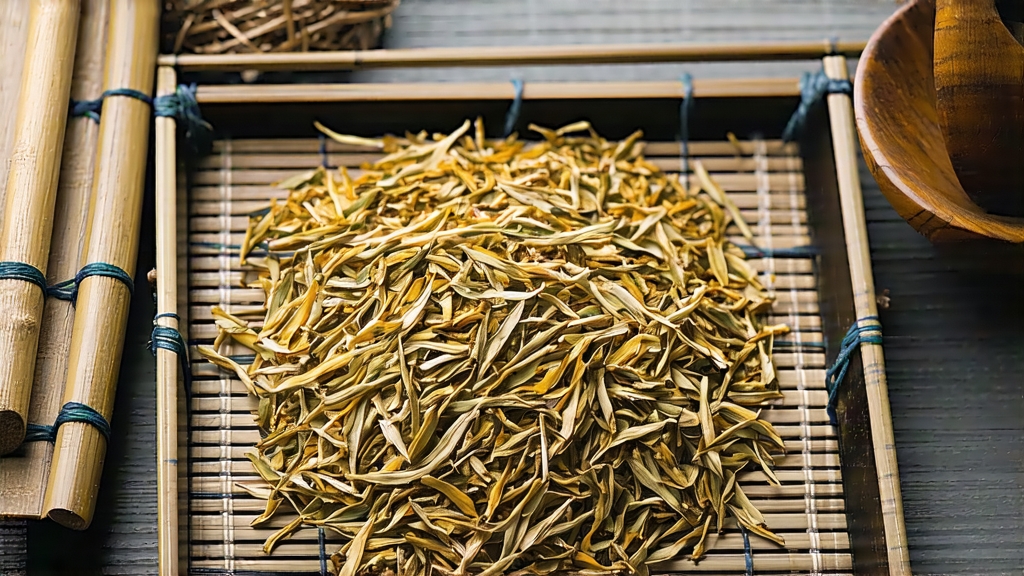
Mengding Huangya, literally “Yellow Bud of Mengding Mountain,” is the most revered expression of China’s rare yellow tea family. Nestled among the perpetual clouds of Ya’an, Sichuan, the mist-shrouded peaks of Mengding have sheltered tea gardens since the mythical era of the Zhou dynasty. Legend credits the Taoist sage Wu Lizhen with planting the first seven bushes on the summit in 53 BCE, an origin story that later earned the hill the honorary title “the Birthplace of World Tea Culture.” For almost thirteen centuries Mengding Huangya was pressed into brick-shaped tribute cakes and carried by horse caravan to the Tang, Song and Ming courts, where its luminous liquor and orchid-sweet finish became the privilege of emperors and the poetic muse of scholars. Today only a precious 300 kg are handcrafted each spring, making it a living relic rather than a mere beverage.
Although yellow tea is often described as a “missing link” between green and oolong, Mengding Huangya refuses to be an intermediate footnote. It belongs to the bud-yellow sub-category, meaning it is fashioned exclusively from the unopened shoot and the single adjacent leaf, picked within a five-day window when the dew still carries mountain chill. The cultivar of choice is the local “Mengding small-leaf,” a landrace that has acclimated to 1 200 m elevations, developing extra theanine and a signature lactone precursor that later translates into the tea’s hallmark “milk-custard” note.
The craft begins at dawn when pickers climb stone steps slick with moss, plucking by touch rather than sight because fog limits visibility to three metres. Baskets must be lined with fresh bamboo leaves to prevent mechanical bruising; any compression would trigger premature oxidation and destroy the jade-green colour of the bud. Back at the cottage the shoots are laid on ramie mats for six hours of withering, a short rest that reduces grassy volatility and coaxes a subtle jasmine-like fragrance.
Next comes the kill-green phase, unique among yellow teas for its dual-temperature approach. A wok is heated to 160 °C with mengzhu (a local bamboo species) charcoal, then cooled to 90 °C within ninety seconds by splashing mountain spring water on the walls. The tea master tosses 250 g of buds at a time, using a wrist motion that mimics the calligraphic stroke “na”: fingers together, palm hollow, a semi-circle that ensures every tip kisses the metal yet never scorches. After four minutes the leaf temperature drops to 45 °C and the enzymes are considered “asleep but dreaming,” a poetic way of saying oxidation pathways are restrained but not erased.
The hallmark of yellow tea now unfolds: men huang, or “sealed yellowing.” The partially fixed buds are wrapped in thin sheets of yellow cotton paper, then stacked inside a bamboo steamer whose lid is lined with wet goat-hide. Every forty minutes the bundles are unwrapped, aired for three minutes, and re-wrapped with a slight change in orientation so that inner and outer layers exchange position. This cycle continues for eight to ten hours through the night, during which chlorophyll gently degrades into pheophytin, polyphenols oxidise just 3–5 %, and a faint Maillard reaction generates tones of toasted sesame and steamed corn. The leaf slowly turns from jade to antique gold, while the bud tip remains silvery, a bicolour contrast that connoisseurs call “golden helmet, silver spear.”
Low-temperature baking finishes the process. Charcoal embers are covered with a 1 cm ash blanket to hold 50 °C for two hours, driving residual moisture down to 5 % without sharpening the flavour. The cooled tea is then rested in unglazed clay jars for at least three weeks so that trapped “fire qi” can dissipate; only after this hibernation is the tea judged ready for market or imperial-style storage.
To brew Mengding Huangya Western readers may find the gongfu approach both theatrical and precise. Begin with soft water whose TDS lies between 30–60 ppm; Himalayan spring water sold in glass bottles works well. Pre-warm a 120 ml porcelain gaiwan by swirling 85 °C water, then discard. Measure 3 g of tea—about twelve buds—and let them slide down the wall so they land in a loose spiral. The first infusion, 30 seconds at 80 °C, awakens the buds; watch